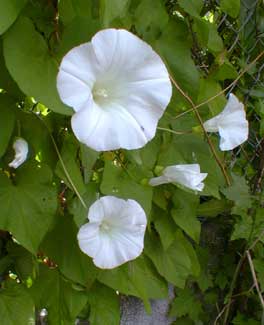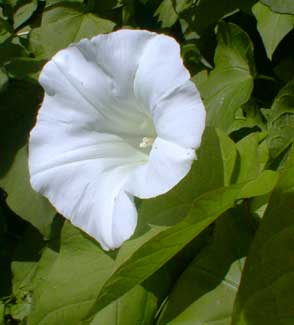
Odious Wild
Perennial Morning Glory
aka Field Bindweed
"Memory comfortless. -- Away! away!
Phantoms, about whose brows the bindweed clings,
Hopeless regret! In thinking of these things
Some men have lost their minds, & others may."
-Edward Robert Bulwer-Lytton, Earl of Lytton
(1831-1892)
(1831-1892)
Field bindweedm European bindweed, or perennial morning-glory (Convolutus arvenis) is also known as small bindweed, lesser bindweed, or small-flowered bindweed. These last are rather misnomers since the vine & the flowers are large, but the similar hedge bindweed (Calystegia sepium) is larger hence by comparison field bindweed is small. It's also known as creeping jenny, though most people would reserve that name for Lysimachia nummularia.
It is additionally called wild morning-glory, European bindweed, devil's guts, barbine, & cornbind, this latter because it invades fields or corn & other grains greatly diminishing the crops.
Field bindweed is one of the most annoying weeds of the Pacific Northwest. It grows so rapidly, twining about everything in counter clockwise turns, so encompassing shrubs & smaller vines that it completely chokes them out from the sun. So it cannot be tolerated for its admitted degree of beauty, as that'd be like turning over a southern garden to kudzu.
 I am 99.9% an organic gardener but a couple of times I have gotten sufficiently frustrated to use herbicides especially on the other side of our fenceline where bindweed had become dense & lush, & where a sudden drop-off makes made it impossible to get in there with a shovel to dig out the roots.
I am 99.9% an organic gardener but a couple of times I have gotten sufficiently frustrated to use herbicides especially on the other side of our fenceline where bindweed had become dense & lush, & where a sudden drop-off makes made it impossible to get in there with a shovel to dig out the roots.Most herbicides aren't all that effective though non-organic gardeners will find some success by using a mixture of a glyphosate product (Roundup is best known) plus a product with triclopyr (Brush B Gone is the best known); or use glyphosate plus a product with dicamba (Banvel is best known). Herbicides can be started in June; its hopeless to try to poison them before June, as they invariably grow back. It will probably have to be done twice before it has a useful effect. Anyone going this route should take all instructions & warnings on the herbicide labels very seriously.
An organic method that works on all other weeds is to smother & cook a weedy area by placing black tarp, black plastic, or tarpaper over the soil in full sun. This will kill everything except the morning-glories in perhaps three months, but the morning glory roots will be alive for three years, so this method would only work for ground that one didn't wish to use for a great long while.
Organic gardeners generally have no choice but to just dig them out, which is an ongoing process. They can't just be pulled because any fragment of the root that remains very quickly generates more vines. When digging the roots are apt to get sliced, & again regenerate new vines.
Two years of digging them out as soon as they are spotted will probably result in victory at at last, but of course birds will bring new seeds into the garden, so there's never really an end to them. Seedlings at least are easily hand-pulled before they become long tenacious roots.
A garden that is near to a field will be invaded by the aggressive root system. If a neighbor's yard is not assiduously kept free of the vines, then there will never be a time when one's own garden will be free of them. They can be kept at bay by sinking barrier material developed for containing bamboo, all along the fence-line to a depth of eighteen inches. Anything less, the roots will find their way under & through.
The bindweed taproot has been documented as penetrating soil to as deep as twenty feet. The fleshy cordlike horizontal roots can travel under roads & sidewalks to erupt in new locations. Each of hundreds of vines generated by the roots creep & crawl to twenty feet or further. Flowers last only one day each & rapidly develop into seeds. Seeds that end up in inhospitable locations can remain alive without germinating for up to fifty years if need be. Seeds are not wind-carried, but are easily moved about by the activity of motor vehicles, or by birds. It can be mildly toxic to livestock, & it can play host to a number of plant viruses which it carries to more easily harmed native forbs.
It is certainly not only the Pacific Northwest troubled by these buggars. It has colonized all the American states including Alaska & Hawaii. The majority of the states, & five Canadian provinces, classify it as a noxious weed. It has also assaulted the native flora of Australia & New Zealand & many other parts of the world.
The only other weed that exceeds its aggressiveness is horsetail, but that at least is a native plant, & I long ago decided to appreciate its beauty rather than be frustrated by the impossibility of its eradication, & they don't hamper all the other plants the way bindweed does. I feel badly that any plant makes me feel even a little hostility, & many other weeds, even the lowly dandylion, or herb robert, or knapweeds, I can find appealing even if I do weed them out of the garden. But the tenacious field bindweed is truly annoying.
Though this wild morning glory loves the Northwest conditions, tamer better morning glories are very hard to grow here in any flowerful way. The morning glory falls under six genera & over 1,600 species, chiefly tropicals but with several almost suited to temperate zones. Some are annuals such as Ipomoea tricolor, I. quamoclit (including Cardinal Climber), or I. nil (which includes the gorgeous Japanese Imperial Morning Glories), while others are perennial: I. acuminata (aka I. leari, aka I. indica) including the popular 'Blue Dawn' Morning Glory, & I. alba the large-flowered white 'Moonflower,' which prefer semi-tropical environments & don't thrive in the Pacific Northwest.
The most gardened genus is Ipomoea, which does not include the annoying wild morning glory. Ipomoe perennials can be somewhat aggressive, spreading by underground runners & by seed, but never the nightmare that wild morning glory bindweeds are. As a rule the fancier cultivars are the least aggressive but nevertheless very reliable climbers with rapid growth, in the appropriate zones. Unfortunately on Puget Sound the Impomea cultivars don't have a long enough hot season to bloom well, so we get nice vines & when they're just getting ready to flower, summer is over & the vines decide not to bloom at all.
The photos on this page were snapped early June in a nearby alley. I don't let them bloom in my yard, but I can't do much about the fact that they grow throughout the neighborhood & some homeowners have either given up or don't care.